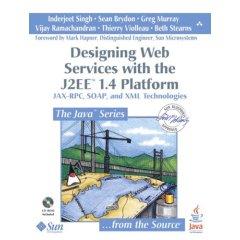| 2020ok Directory of FREE Online Books and FREE eBooks |
Free eBooks > Computers & Internet > Web Development > Internet Commerce > Web Site Design > Designing Web Services With The J2ee 1.4 Platform: Jax-rpc, Soap, And Xml Technologies
Designing Web Services With The J2ee 1.4 Platform: Jax-rpc, Soap, And Xml Technologiesby Inderjeet Singh, Sean Brydon, Greg Murray, and Vijay Ramachandran  Download Book (Respecting the intellectual property of others is utmost important to us, we make every effort to make sure we only link to legitimate sites, such as those sites owned by authors and publishers. If you have any questions about these links, please contact us.) link 1 link 2 About Book Book Description This authoritative guide -- written by members of the Java BluePrints team at Sun Microsystems -- spells out the proven best practices for designing and developing enterprise-level Web services using J2EE 1.4. Web services are key for business-to-business interaction and enterprise application integration. This in-depth book provides all the information and advice that every developer needs to know in order to design and integrate effective web services with the new J2EE 1.4 platform. The Java BluePrints team has written extensively on J2EE enterprise applications, developed and documented design patterns, and has developed two sample applications to illustrate their guidelines and recommendations. All of their best information is shared through this supremely useful new book. From the Back Cover Written by Sun Microsystems' Javaâ„¢ BluePrints team, Designing Web Services with the J2EEâ„¢ 1.4 Platform is the authoritative guide to the best practices for designing and integrating enterprise-level Web services using the Java 2 Platform, Enterprise Edition (J2EE) 1.4. This book provides the guidelines, patterns, and real-world examples architects and developers need in order to shorten the learning curve and start building robust, scalable, and portable solutions. The authors use the Java Adventure Builder application to bring the design process to life and help illustrate the use of Java APIs for XML Processing (JAXP), Java APIs for XML-Based RPC (JAX-RPC), and other Web service and Java-XML technologies. Key topic coverage includes: Designing Web Services with the J2EEâ„¢ 1.4 Platform provides the insight, advice, and detail that make it easier to create effective Web service applications using the J2EE 1.4 platform. About the Author Inderjeet Singh is lead architect on the Java BluePrints Team, where he works with other architects and engineers to define best uses of Java technologies for application design. Beth Stearns is the principal partner of ComputerEase Publishing, a computer consulting firm she founded in 1982. Among her publications are Java Native Interface in The Java Tutorial Continued (Addison-Wesley), “The EJB Programming Guide†for Inprise Corporation, and “ Understanding EDT, †a guide to Digital Equipment Corporation's text editor. Excerpt. © Reprinted by permission. All rights reserved. This book describes designing Web services using the current technologies available with the Java™ 2 Platform, Enterprise Edition. This book and the accompanying Java™ Adventure Builder Reference application (hereafter referred to as adventure builder) are part of the successful Java BluePrints program created by Sun Microsystems with the introduction of the J2EE platform. Application architects, developers, and students everywhere have used this program to better understand the programming model inherent in the J2EE platform. Rather than providing information on how to use individual Java technologies to write applications, which falls within the realm of the companion Java Tutorial program, the Java BluePrints focuses on guidelines for application architecture and design, such as distributing J2EE application functionality across tiers and choosing among design options for Web services endpoints. This book describes the Web services and related technologies of the J2EE platform. Its focus is how to best apply these J2EE platform technologies to writing Web service applications. This book assumes that you have a basic knowledge of the J2EE platform, which you can get from The J2EE™ Tutorial, and is meant to be read in conjunction with Designing Enterprise Applications with the J2EE Platform, Second Edition, since that book covers the J2EE platform technologies for writing traditional enterprise applications. This book is intended primarily for enterprise architects and application developers engaged in or considering writing Web services and Web service applications with the J2EE platform. It is also useful for product vendors interested in developing Web service applications consistent with the J2EE platform standard. Obtaining the Reference ApplicationThe adventure builder reference application, which is described in this book, is available on the compact disk included with this book. You can also download it from: http://java.sun.com/blueprints/code/The application requires a J2EE version 1.4-compliant platform on which to run. The accompanying compact disk includes an implementation of this platform and an application server. You can download the J2EE SDK™, which is a freely available implementation of that platform, from: http://java.sun.com/j2ee/download.htmlThe Java BluePrints Web site includes additional content, available only online, that describes in detail the architecture of the Java adventure builder sample application. References and ResourcesPointers to J2EE documentation can be found at: http://java.sun.com/j2ee/1.4/docsFor information on how to use the J2EE SDK to construct multi-tier enterprise applications, refer to the J2EE Tutorial, available at: http://java.sun.com/j2ee/1.4/docs/tutorial/docsWe relied on many of the following references for technical details and background. These references are good sources for those interested in exploring Web services in greater detail.
The Web services standards cited in this book are:
The J2EE technologies cited in this book are described in their specifications:
How This Book Is OrganizedThis book is divided into the following chapters:
Related Free eBooks
| Related Tags |












SEND A COMMENT
PLEASE READ: All comments must be approved before appearing in the thread; time and space constraints prevent all comments from appearing. We will only approve comments that are directly related to the article, use appropriate language and are not attacking the comments of others.